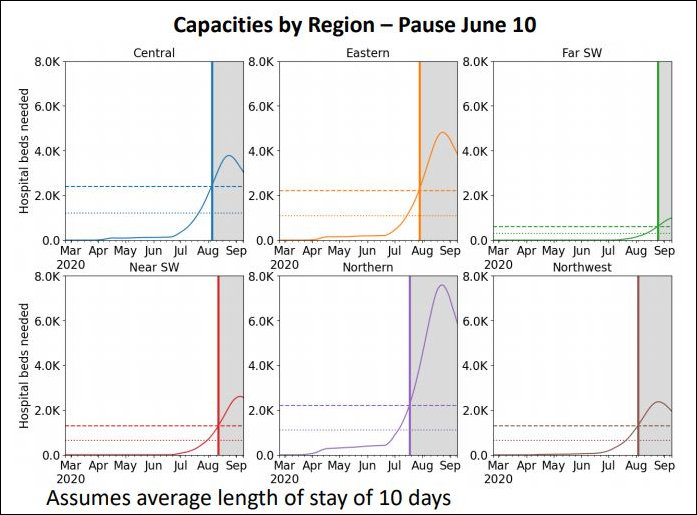
by James A. Bacon
John Butcher and I have been cautiously optimistic that the COVID-19 epidemic is near its peak in Virginia, and that Virginia hospitals seem to be in little danger of being overwhelmed. Now comes the University of Virginia’s Biocomplexity Institute, which has developed a sophisticated, Virginia-specific epidemiological model. The Institute agrees that social-distancing restrictions are working, but warn that the epidemic could heat back up if they are relaxed.
Back in January, the administration asked the Institute to design an epidemiological model as a decision-support tool for Virginia public health officials. The Institute has done so, and yesterday it released its first publication, “Estimation of COVID-19 Impact in Virginia.” Institute leaders also elaborated on their model Monday in a press conference with Governor Ralph Northam Monday.
Under a scenario in which current restrictions are maintained through June 10th in line with Northam’s stay-at-home order and in which public activity changes “halfway” back to normal afterwards, the epidemic could peak in August-September, reports the Richmond Times-Dispatch. In that case, hospitals could be overwhelmed across the state, with the most severe problems in Northern Virginia.
The Institute factored some interesting data into its model, including Google mobility data showing a 44% decrease in retail & recreation activity, 18% reduction in grocery stores, and 39% decrease in workplaces. Cuebiq data shows a 50% reduction in average individual mobility. Meanwhile, the UVa quant jocks hope to improve the model by such techniques as incorporating age structure into its transmission dynamics and assessing evidence for the role of seasonality.
It’s reassuring to see that the Northam administration has its own Virginia-specific epidemiological model and that it’s maintained by people who know what they’re doing. It’s likewise reassuring to know that the Northam team had the foresight to ask the Biocomplexity Institute as early as January to work on the project. Now the administration can make better-informed decisions about when, and to what degree, it can start rolling back its social-distancing restrictions.
We can still debate the trade-offs between public safety, the economy, and individual liberties. But we can do with a clearer idea of what those trade-offs are. Well, maybe “clearer” is overdoing it. But in the land of the blind, the one-eyed man is king — even if he has cataracts and macular degerneration.
Update: John Butcher is less impressed. “Lots of grant $ and computer time to tell us what we already knew.”

Leave a Reply
You must be logged in to post a comment.